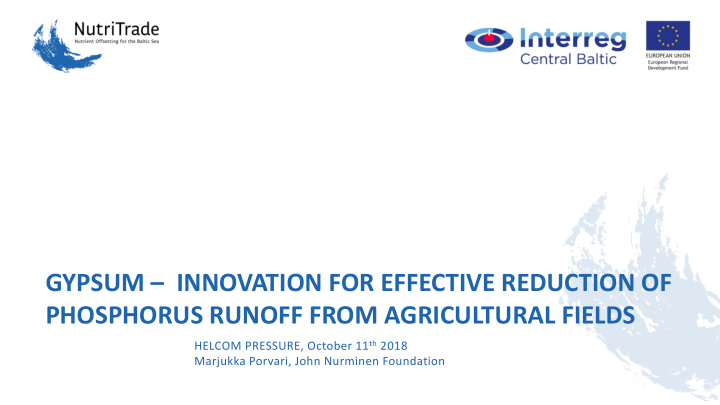



GYPSUM – INNOVATION FOR EFFECTIVE REDUCTION OF PHOSPHORUS RUNOFF FROM AGRICULTURAL FIELDS HELCOM PRESSURE, October 11 th 2018 Marjukka Porvari, John Nurminen Foundation
BENEFITS OF UTILIZING GYPSUM (CaSO4 ·2H 2 O) IN FIELDS Immediate reduction in phosphorus and suspended solids run- off ≈ 50%. Unlike most other agricultural water protection measures, reduces both particulate and dissolved reactive phosphorus. According to studies, effect lasts at least five years. Recycled side- stream gypsum from e.g. fertiliser, sugar and energy production can be utilized (note: must be free of harmful substances). Cost with recycled gypsum 70 €/kgP - only 1/3 of the other agri- environmental measures. Ordinary lime- or manure-spreading machinery can be utilised for spreading. Suitable for clay fields, in the Baltic Sea region especially in Denmark, Estonia, Finland, Poland and Sweden. Main limitations: not in drainage areas of lakes or ground water areas due to sulfur . Phosphorus reduction potential in Finland estimated to be 200–300 tonnes/year, in the whole Baltic Sea region 1500 - 2000 tonnes/year.
HOW GYPSUM WORKS? Run-off waters Less particulate and dissolved reactive • CaSO 4 ∙ 2H 2 O phosphorus Less erosion • Gypsum leaches out slowly, effect • estimated to last 5 years Soil Dissolution Ca 2+ + SO 4 Improves soil structure 2− • Ionic strength of soil pore water increases Electric double layer surrounding soil particles becomes thinner • Soil particles form larger aggregates → less prone to erosion • Also runoff of dissolved reactive phosphorus reduces, at the same • time phosphorus stays in plant available form + + + Unlike lime (CaCO 3 ) gypsum does not impact soil pH + ++ + + + + + + - - - - - - - - - - - - + + + + + + + + + + - - - + + + + + + - - - + + After gypsum Before gypsum
STRONG EVIDENCE - STUDIED IN FIELD SCALE SINCE 2007 Kemira Growhow (2007): laboratory tests TraP-project (2007-2013) - SYKE, University of Helsinki, MTT and TTS Research Laboratory analyses Field tests in Nummenpää (continuos water quality monitoring) and MTT research station in Jokioinen Spreading tests Economic analyses NutriTrade and SAVE projects (2015 -2018) – University of Helsinki and SYKE Field application to 1550 ha in the river Savijoki catchment Continuous water quality monitoring (suspended solids, phosphorus) Analysis of impacts on trout spawning, fish populations, mussels, water moss, diatoms, ground waters, phosphorus release from sediments, soil chemistry Analysis of farmers’ views and acceptance of the measure Vantaanjoki river project (2018-2020) Field application to 3500 ha in the river Vantaanjoki catchment Continuos water quality sampling (suspended solids, phosphorus) Analysis on impacts on trout spawning and fish populations
More information Policy briefs http://nutritradebaltic.eu/wp - content/uploads/sites/34/2018/05/NutriTrade -Policy-Brief-1-Gypsum-Amendment- and-Large-Scale- Use.pdf http://nutritradebaltic.eu/wp - content/uploads/sites/34/2018/05/NutriTrade -Policy-Brief-2-Gypsum-Amendment- and- Policy.pdf Published articles Ekholm, P., Valkama, P., Jaakkola, E., Kiirikki , M., Lahti, K., & Pietola, L. (2012). Gypsum amendment of soils reduces phosphorus losses in an agricultural catchment . Agricultural and Food Science , 21 (3), 279- 291. https://doi.org/10.23986/afsci.6831 Uusitalo, R., Ylivainio, K., Hyväluoma, J., Rasa , K., Kaseva, J., Nylund, P., Pietola, L., & Turtola, E. (2012). The effects of gypsum on the transfer of phosphorus and other nutrients through clay soil monoliths . Agricultural and Food Science , 21 (3), 260 - 278. https://doi.org/10.23986/afsci.4855 Jaakkola, E., Tattari, S., Ekholm, P., Pietola, L., Posch , M., & Bärlund, I. (2012). Simulated effects of gypsum amendment on phosphorus losses from agricultural soils . Agricultural and Food Science , 21 (3), 292- 306. https://doi.org/10.23986/afsci.6773 Iho, A., & Laukkanen, M. (2012). Gypsum amendment as a means to reduce agricultural phosphorus loading: an economic appraisal. Agricultural and Food Science , 21 (3), 307- 324. https://doi.org/10.23986/afsci.6832 Contact information Markku Ollikainen, Professor, University of Helsinki, p. +385 2941 58065, markku.ollikainen@helsinki.fi Petri Ekholm, Senior Researcher, Finnish Environment Institute, p. +385 2952 51102, petri.ekholm@ymparisto.fi Eliisa Punttila, Project Manager, University of Helsinki, p. +385 2941 58061, eliisa.punttila@helsinki.fi
Recommend
More recommend